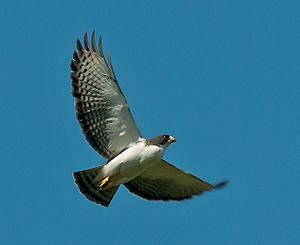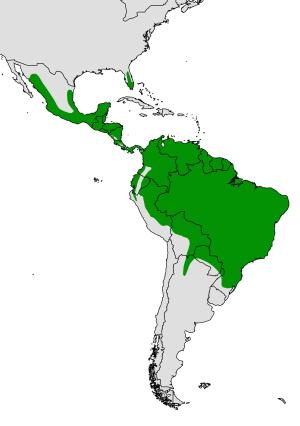Short-tailed hawk facts for kids
Quick facts for kids Short-tailed hawk |
|
|---|---|
 |
|
| Adult flying in São Paulo, Brazil | |
| Conservation status | |
| Scientific classification | |
| Genus: |
Buteo
|
| Species: |
brachyurus
|
| Subspecies | |
|
|
 |
|
| Synonyms | |
|
Buteo fuliginosus |
|
The short-tailed hawk (Buteo brachyurus) is a fascinating bird of prey that lives in the Americas. It's part of the Accipitridae family, which includes other powerful birds like eagles. Even though its name has "hawk" in it, this bird is actually a type of "buteo" or "buzzard." It's a close relative of the white-throated hawk.
Contents
Where They Live
Short-tailed hawks live in warm, tropical, and subtropical parts of the Americas. You can find them from southeastern Brazil and northern Argentina, all the way north through Central America, up to the mountains near the Mexico-Arizona border. They also live in southern Florida, United States.
These birds usually prefer areas below 1,370 meters (about 4,500 feet) above sea level. They are most common below 760 meters (about 2,500 feet). Another hawk, the white-throated hawk, lives in the Andes mountains further south.
Most short-tailed hawks stay in the same place all year. However, many from Florida fly south for the winter. They can live in different types of wooded areas. This includes wooded grasslands, forests near water, and even swamps. They usually avoid places with lots of people.
Most of what we know about these hawks comes from studying the ones in Florida. So, some things might be different for the hawks living in other parts of their range.
What They Eat and How They Hunt
In Florida, short-tailed hawks mainly eat smaller birds. They hunt by flying high in the sky, often near the edges of forests and open areas. A cool hunting trick they use is "kiting." This is when the hawk stops in the air, facing into the wind, with its wings held still.
When they spot prey, they usually swoop down very fast. Sometimes they pause in mid-air before continuing their dive. Their prey can range from small New World warblers to larger birds like bobwhites. In Florida, they mostly eat birds like red-winged blackbirds and common grackles. Sometimes, almost all of a hawk's diet can be just one type of bird!
Hunting is hard work for these birds. One study showed that only about 11% of their hunting attempts were successful. Sometimes, they even catch other birds of prey, like sharp-shinned hawks or American kestrels.
In tropical areas, short-tailed hawks eat more than just birds. They also hunt frogs (especially tree frogs), lizards, and large insects like wasps and locusts. These foods are not as common for the Florida hawks. They also sometimes eat small mammals, like mice, rats, and bats. Very rarely, they might even catch young common marmosets (small monkeys).
These hawks usually catch their food by diving from the air onto trees or the ground. It's rare for them to hunt from a perch.
Building a Home and Raising Chicks
Short-tailed hawks build their large nests out of sticks in trees. These nests can be anywhere from 2.5 to 30 meters (about 8 to 98 feet) high. In Florida, they often choose bald cypress trees for nesting.
Their nests are quite big, about 60 to 70 centimeters (24 to 28 inches) wide and 30 centimeters (12 inches) deep. The female hawk lays 1 to 3 eggs in each clutch. The eggs are white, often with dark spots.
In Florida, the nesting season is from January to June. It's probably similar in tropical areas. The eggs hatch after about 34 days. We don't know much about how long the young birds stay in the nest after hatching. Sadly, American crows have been known to eat the eggs of these hawks in Florida.
How Many Are There?
The short-tailed hawk is not very common in most places where it lives. It can be hard to spot because it often hides in dense trees when resting. Unlike many other "buteo" hawks, it doesn't usually sit on open branches.
Because they are so good at hiding, it's hard to count how many there are. No full surveys have been done to count their population. However, because they live in such a large area, the IUCN doesn't consider them to be in danger. If you're in their habitat, you might often see them soaring high in the sky!
See also
 In Spanish: Gavilán rabicorto para niños
In Spanish: Gavilán rabicorto para niños



